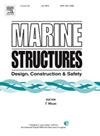A structural safety evaluation approach of offshore wind turbine based on projection pursuit method and extension cloud model
IF 5.1
2区 工程技术
Q1 ENGINEERING, CIVIL
引用次数: 0
Abstract
The offshore wind power (OWP) industry is developing towards deep sea areas, and thus the offshore wind turbine (OWT) will face more severe environmental conditions and excitations such as storms, typhoons and huge waves. The safety evaluation and early warning of OWT structures has become the key issue to ensure the stable operation of offshore wind farm (OWF) and the sustainable development of the OWP industry. In this research, one structural safety evaluation approach of OWT was proposed based on projection pursuit (PP) method and extension cloud model (ECM), and the evaluation results were discussed by considering two actual OWTs as the research objects. Firstly, the multivariate evaluation index system was established based on the safe threshold of different indexes calculated from numerical models of two OWT in the perspectives of time and frequency domain. Secondly, an index weight optimization method was proposed based on PP and particle swarm optimization (PSO) algorithm to accurately determine the importance of each indicator for safety evaluation. The ECM, which can leverage the advantages of normal cloud theory and extension model, was also utilized to establish a multi-level and multi-index safety evaluation method for OWT. The feasibility of the novel approach was further verified through the both randomly generated samples and typical measured data. Especially, one set of measured data, which shows the occurrence of excessive vibration for OWT, can be evaluated as a sub-healthy status. This result can effectively demonstrate the engineering applicability of the proposed method. Lastly, the influence of wind speed, rotation speed and power on the health status of OWT and its change rule was discussed considering the long-term monitoring data for one year. It is expected that the proposed approach can provide necessary assistance for the safe operation and intelligent maintenance of OWFs.
基于投影追寻法和扩展云模型的海上风力涡轮机结构安全评估方法
海上风电(OWP)产业正在向深海区域发展,因此海上风电涡轮机(OWT)将面临更恶劣的环境条件和激励,如风暴、台风和巨浪。海上风电机组结构的安全评估与预警已成为确保海上风电场(OWF)稳定运行和海上风电产业可持续发展的关键问题。本研究提出了一种基于投影追寻(PP)方法和扩展云模型(ECM)的海上风电场结构安全评价方法,并以两座实际海上风电场为研究对象讨论了评价结果。首先,从时域和频域的角度,根据两个 OWT 数值模型计算出的不同指标的安全阈值,建立了多元评价指标体系。其次,提出了一种基于 PP 和粒子群优化(PSO)算法的指标权重优化方法,以准确确定各指标在安全评价中的重要性。此外,还利用 ECM 可以发挥正常云理论和扩展模型的优势,为 OWT 建立了多层次、多指标的安全评价方法。通过随机生成的样本和典型的测量数据,进一步验证了新方法的可行性。其中,一组测量数据显示出 OWT 发生了过度振动,可被评估为亚健康状态。这一结果有效证明了所提方法的工程适用性。最后,考虑到一年的长期监测数据,讨论了风速、转速和功率对风电机组健康状况的影响及其变化规律。预计所提出的方法可为风力发电机的安全运行和智能维护提供必要的帮助。
本文章由计算机程序翻译,如有差异,请以英文原文为准。
求助全文
约1分钟内获得全文
求助全文
来源期刊

Marine Structures
工程技术-工程:海洋
CiteScore
8.70
自引率
7.70%
发文量
157
审稿时长
6.4 months
期刊介绍:
This journal aims to provide a medium for presentation and discussion of the latest developments in research, design, fabrication and in-service experience relating to marine structures, i.e., all structures of steel, concrete, light alloy or composite construction having an interface with the sea, including ships, fixed and mobile offshore platforms, submarine and submersibles, pipelines, subsea systems for shallow and deep ocean operations and coastal structures such as piers.
 求助内容:
求助内容: 应助结果提醒方式:
应助结果提醒方式:


